Tag Archives: Watermen

Reins Loosened Slightly On Chesapeake Bay Crab Harvest
“We’re being cautious, but I think we’re being responsible,” said Ed Tankard, a board member with the Virginia Marine Resources Commission, which voted June 27 to ease certain bushel limits. In Maryland, the state Department of Natural Resources announced on the same day a raft of industry-friendly changes to its crab controls, including modestly increasing the allowable harvest of female crabs and lifting limits on the harvest of males over Labor Day weekend. Those moves came a few weeks after the panel that regulates the Potomac River’s fishing industry agreed to roll back bushel limits on female crabs to 2021 levels. >click to read< 12:21
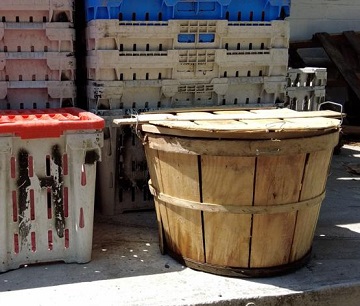
Proposed Pilot Program For Female Blue Crabs
A new pilot program introduced by the Department of Natural Resources has watermen frustrated. It’s with the possible implementation of plastic, rectangular containers called lugs. Currently, caught male blue crabs are able to be placed in lugs, but females are not. So watermen feel the program comes with a lot of hoops to jump through and they ask why the need for the program at all. Lugs are bigger than your typical bushel basket of crabs. Bushels hold about 40 pounds and lugs hold 60. DNR has introduced the idea of using lugs for female crabs. But with that comes rules that participating watermen (in the pilot program) must follow. >click to read< 12:30

‘The seafood industry is significant to Maryland’s economy and identity’
Maryland’s seafood industry has long been the envy of markets around the country, providing more than $600 million each year to the state economy. Stone Slade, seafood marketing director for Maryland’s Department of Agriculture, said it isn’t hard to locate a “fresh catch” and the industry plays a key role in shaping the state’s identity. “The seafood industry contributes $600 million to the state’s economy, employs thousands of workers, has annual commercial landings averaging over 56 million pounds, and an annual dockside value of $95 million.” >click to read< 11:20

Maryland to restrict crabbing, including first-ever limits on harvest of male blue crab
Regulations issued this week, to be in effect from July through December, will limit commercial watermen to at most 15 bushels a day of male crabs in August and September. And the regulations will tighten existing restrictions on how many female crabs watermen can catch. The changes come weeks after an annual survey of Chesapeake blue crabs,,, That state fishery managers moved to limit even the harvest of male crabs demonstrates the gravity of the situation. Limits are typically only imposed on female crabs as a means of ensuring enough of them to survive to spawn, but with a more than 60% decline in the overall estimated blue crab population since 2019, scientists and representatives from the seafood industry are signaling that more protections are needed to help boost crab reproduction. >click to read< 16:02

Chesapeake Bay blue crabs in trouble, tighter harvest restrictions loom
With the Chesapeake Bay’s crab population at its lowest ebb in more than 30 years, Maryland and Virginia are moving to curtail harvests in one of the region’s most valuable fisheries. Fisheries regulators in both states have proposed new catch restrictions, with plans to finalize them by the end of June. In Maryland, tighter limits for both commercial and recreational crabbing would take effect in July and for the first time would limit commercial harvests of male crabs, not just females. New commercial restrictions in Virginia would begin in October and continue until the crabbing season ends Nov. 30. >click to read< 08:17

A Place Called Guinea – In Gloucester County, a centuries-old culture with its own dialect endures.
This place is where watermen weathered rugged conditions all day every day, fishing the rivers, dredging the oysters, and hauling in crab pots to harvest the seemingly endless bounty of the Chesapeake Bay. Smelling like fish, dismissive of their swollen hands and knuckles, these same men would later gather in a general store, you could find one on almost every corner, and swap stories over whose catch was the biggest. “Whoever was louder was the winner,” says fireman Nick Bonniville, whose father, grandfather, and a generation of great grandfathers all worked the Guinea waters. >click to read< 08:15

A message for Del. Jay Jacobs – This will not go unanswered.
Recent actions that you have taken, makes me put this letter together to address the situations at hand. First of all, your contact with an individual in Cecil County and the information that you gave him concerning Delmarva Fisheries Association is of great concern to all of us at DFA and our local affiliates,,, DFA was referred to as nothing but a scam just like the Chesapeake Bay Foundation, and it was said that DFA receives large sums of money directly from the sale of fishing licenses in the state. These two comments stated at a public meeting in Cecil County are outright lies and misinformation. The gentleman who spoke said he got this information from you and you alone! This will not go unanswered. >click to read< 09:11

Watermen tackle offshore wind farm development concerns, company pushes (subsidized) economic benefit
“I just want to be able to go fishing.” Those were fisherman Jimmy Hahn’s words as he is one of many who are concerned about U.S. Wind offshore wind developments. Now with political leaders on their side, watermen hope to see some change moving forward. “Those guys have really stepped up to the plate. “People who buy electricity in the state are paying an extra amount in order to subsidize the windmills. That means that someone should stand up for these taxpayers. If we’re going to spend taxpayer dollars to build these windmills and subsidize them there should be proper oversight,” Representative Harris said. Another concern that came up Wednesday by waterman and Congressman Harris was the possibility of U.S. Wind not being an actual U.S. based company. >click to read< 09:03
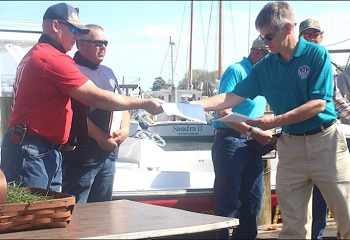
Tilghman Island Blessing of the Fleet: Watermen, first responders honored for life-saving rescue
The watermen’s fleet has officially been blessed, along with five men who rescued a waterman earlier this year and saved his life after falling overboard into the Chesapeake Bay’s cold waters. Public officials, community and religious leaders and locals gathered at Dogwood Harbor in Tilghman Island on Sunday, April 11, to give their blessings to the watermen. The ceremony offers good graces to the seafood catchers as they prepare to fish, crab and oyster in the Bay and its tributaries this year. The annual “blessing of the fleet,” comes just after crabbing season officially began on April 1. photos, >click to read< 08:42

Maryland oyster industry may be forever altered by Coronavirus pandemic
The pandemic-impacted oyster season has been difficult for the industry in Maryland, causing farmers and watermen to rethink how they sell their product and changing how programs conduct oyster restoration. Robert Brown, waterman and oyster grower, has bottom oyster leases on the tributaries of the Potomac River. Brown, president of the Maryland Watermen’s Association, said he sells the majority of his oysters to oyster packaging houses, which aren’t working at capacity because they can’t sell the oysters once they shuck them. Watermen are being hit hard in the pandemic, and it might be a few years before we get back to normal,,, >click to read< 08:36

‘Mask police’: Commercial fishermen, watermen required to wear masks on boats via Biden, Coast Guard COVID orders
The U.S. Coast Guard is requiring masks be worn on commercial fishing boats and other vessels as part of President Joe Biden’s executive orders mandating face coverings on federally regulated transportation vehicles.,, Now, they are also going to be enforced on watermen and those working on fishing boats, according to the Coast Guard. U.S. Rep. Andy Harris, R-Md.-1st, said mandating the mask on watermen and fishermen working outdoors is burdensome, goes against the science of how of and where COVID is spread and could require masks to be worn at all times on boats, including while sleeping. >click to read< 19:10
Congressman Harris Asks for Clarification on Mask Mandate for Small Craft Fishing Vessels – The Coast Guard has issued guidance that all commercial fishing vessel occupants will be required to wear masks, and that they will enforce this mandate. >click to read<

Oyster Prices Plummet As Diners Stay Home Amid Pandemic
With several hours of daylight to spare, Ronnie Robbins and his son, Jason, had already docked their 36-foot deadrise workboat on Hooper’s Island and started unloading their briny cargo.,,, It isn’t a supply problem. Watermen in Maryland and Virginia alike say they are having no trouble landing their daily wild oyster quotas.,,, “We got lots of oysters, and they’re excellent quality,” said Bill Sieling,,, The problem is decreased demand caused by the coronavirus pandemic. >click to read< 09:31

Elected Officials Hear Concerns From Watermen
Elected officials assured commercial watermen they heard their concerns at a meeting last week. On Oct. 16, Congressman Andy Harris joined Sen. Mary Beth Carozza and Delegate Wayne Hartman to meet with commercial fishermen at the West Ocean City Commercial Harbor. Harris offered support as they pursue changes to ensure local watermen can continue to earn a living. “You just tell us when and to whom we have to make the case,” Harris said. Harris joined Carozza and Hartman at Sea Born Seafood last Friday to talk about issues facing local fishermen. Sonny Gwin, who operates the Skilligallee, stressed the importance of maintaining local boats’ ability to fish for black sea bass. Watermen also asked Harris to work toward increasing limits on red crabs. >click to read< 12:20

Maryland’s wild oyster harvest doubles from last year
Despite having fewer days to work, Maryland watermen harvested nearly twice as many wild oysters last season as they did the previous year, state officials report. Even so, a new study finds the state’s population of bivalves is in much better shape now than it was two years ago, with abundance up and overfishing down. As a result, state fisheries managers say they’re weighing whether to maintain catch restrictions put in place last season or relax them for the next wild harvest season, which normally begins Oct. 1. Data presented Monday night to the Department of Natural Resources’ Oyster Advisory Commission indicates that the overall abundance of adult, market-size oysters in Maryland’s portion of the Chesapeake Bay has rebounded considerably since 2018 and is now at the fifth highest level since 1999. >click to read< 17:01

Md. crabbing industry fears long-term impacts of 2020 visa shortages – “Finding Americans that are willing to do this job, it’s not happening.”
Maryland’s famous crab industry is facing an uphill battle. With another year of visa caps, there’s a severe shortage of migrant workers to work as crab pickers ― and few Americans willing to do the job. This year, Maryland crabbers fear for the life of an industry that has been in their families for generations. Only nine crab processors ― which represent 95% of the state’s crab meat production ― remain in Maryland. The processors ― or picking houses ― rely on about 500 foreign seasonal workers to pick crabmeat each year. To work in the United States those workers need H-2B visas designated for temporary non-agricultural workers. >click to read< 18:54
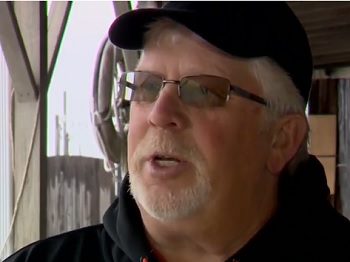
Coronavirus: Maryland seafood industry affected by outbreak
“Right now, the climate in the seafood business is absolutely horrific ever since the announcements that eat-in restaurants were shut down. We really took it on the chin. It virtually shut down the last two weeks that were left in the oyster season,”, Out on the water, those who catch the oysters are feeling the pain, as well, on what was set to be one of the better oyster seasons on record. “It kind of put us out of business and now we’re looking at spring fishing and going into summer fishing, and the markets are slowed almost to a standstill for that and now we’re worried about the crabs,” said Jim Reihl, Maryland Oysterman’s Association president. Video, >click to read< 13:57

Watermen take to the streets to protest
About 100 members of the Talbot Waterman’s Association lined up in front of the Easton Shore Land Conservancy to protest in the early morning hours of Wednesday, Feb. 26. The group is taking issue with the conservancy’s and Chesapeake Bay Foundation’s lack of effort to work with the watermen in a way that allows them to make a living, they said. The evening before the protest, a group of about 200 watermen gathered in Annapolis to address Senate Bill 948, sponsored by state Sen. Paul G. Pnsky, D-22-Prince George’s, that would reduce unlimited tidal fishery license holders’ ability to harvest oysters. >click to read< 21:23

Blended Waters: It’s simply unbelievable!
It’s safe to assume that most of our population enjoys seafood and it’s likely that if you’re reading this, you do as well. I know I do. But not everyone who enjoys a plate of fish, shrimp, crab etc. realizes what goes into retrieving the delicious seafood we eat. Please let me enlighten you just a bit.,, Most of the fishermen I know are very serious about what they do. They work hard . . . always, but when the weather’s against them . . . they hardly work. It isn’t because they’re lazy or irresponsible, it’s because no vessel owner or operator in their right mind will venture off shore if he/she feels the risk is too great; not to mention the expenditures just laid out for the “trip.” If a nor’easter is headed our way, leaving the dock isn’t wise. >click to read<

Watermen get say on how to tackle ‘ghost pots’ in the Chesapeake Bay
“Ghost pots” remain a menace in the Chesapeake Bay, but how big a menace and what to do about them is anybody’s guess. That could change now that the 1,056 hard crab fishermen licensed in Virginia are getting a chance to have their say. Researchers at the Virginia Institute of Marine Science are mailing surveys to watermen asking for their ideas on the countless crab pots that, for any number of reasons, end up haunting the bay, trapping and killing crabs and other hapless creatures that crawl or swim inside. >click to read<14:58
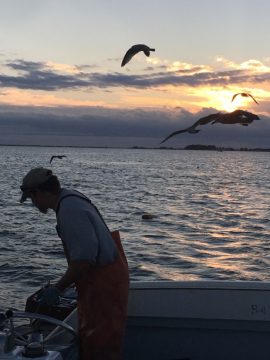
History — and crabbing — run deep in the Chesapeake Bay town of Hampton
It’s well before dawn and I’m driving through the darkness down a rutted dirt lane toward a small commercial boat marina on the outskirts of Hampton, Va. Pulling up, I can just make out the figure of Lee Smith in the light of a streetlamp. Smith is a fourth-generation Chesapeake Bay waterman who has agreed to take me out on his fishing boat while he harvests blue crabs.,,, “I’m a waterman, not a fisherman,” Smith told me, explaining that while he does trawl for fish, he does much more, including crabbing, clamming and oystering. Watermen have to be versatile to make a living, he says, and that means possessing the skills and equipment to catch whatever is both legally fishable and abundant enough to make money. click here to read the story 20:11
No sanctuary for fishermen
 Sanctuaries are designated areas intended to provide a safe haven and protection. But for the watermen of the Chesapeake Bay and its surrounding tributaries, the word “sanctuary” is more often associated with anguish. So when the National Oceanic and Atmospheric Administration’s (NOAA) Office of National Marine Sanctuaries initiated the designation process for Mallows Bay – Potomac River on October 7 of 2015, the watermen of the Potomac River began to grow wary of their future. On February 1, an assorted group of commercial fishermen from all across the Northern Neck of Virginia met with Maryland commercial fishermen at Mundy Point at Pride of Virginia Seafood and Trucking, Inc. to form together as the newly named Potomac River Working Watermen Association (PRWWA). One month later, on March 2, they held their second meeting to discuss their plan of action in opposition of the Mallows Bay – Potomac River sanctuary proposal. continue reading the story here 14:35
Sanctuaries are designated areas intended to provide a safe haven and protection. But for the watermen of the Chesapeake Bay and its surrounding tributaries, the word “sanctuary” is more often associated with anguish. So when the National Oceanic and Atmospheric Administration’s (NOAA) Office of National Marine Sanctuaries initiated the designation process for Mallows Bay – Potomac River on October 7 of 2015, the watermen of the Potomac River began to grow wary of their future. On February 1, an assorted group of commercial fishermen from all across the Northern Neck of Virginia met with Maryland commercial fishermen at Mundy Point at Pride of Virginia Seafood and Trucking, Inc. to form together as the newly named Potomac River Working Watermen Association (PRWWA). One month later, on March 2, they held their second meeting to discuss their plan of action in opposition of the Mallows Bay – Potomac River sanctuary proposal. continue reading the story here 14:35
Watermen’s Appreciation Day – A day on the bay of the Eastern Shore
 “In Maryland here were called watermen which is a term that’s -a follower, we’re not only crabbers, we’re clammers, we’re oyster men, we’re hunters, we’re fishermen, we do it all,” said Captain Robert Newberry of the Watermen’s Association. This all used to be done be sail . The Chesapeake Bay is the largest estuary in the world and the heritage of the Watermen’s appreciation day celebrates just that. This is the 7th annual event here at St. Micheal’s celebrating the eastern shores’ watermen. And folks came from all over to enjoy it. The Boat docking contests took the win for entertainment at the event as folks from age 14 to 60 tried docking their boats the fastest and the smoothest – all for bragging rights. Read the rest here 08:20
“In Maryland here were called watermen which is a term that’s -a follower, we’re not only crabbers, we’re clammers, we’re oyster men, we’re hunters, we’re fishermen, we do it all,” said Captain Robert Newberry of the Watermen’s Association. This all used to be done be sail . The Chesapeake Bay is the largest estuary in the world and the heritage of the Watermen’s appreciation day celebrates just that. This is the 7th annual event here at St. Micheal’s celebrating the eastern shores’ watermen. And folks came from all over to enjoy it. The Boat docking contests took the win for entertainment at the event as folks from age 14 to 60 tried docking their boats the fastest and the smoothest – all for bragging rights. Read the rest here 08:20
‘Oyster wars:’ Watermen aim to take back oyster bars as state panel reviews shellfish sanctuaries
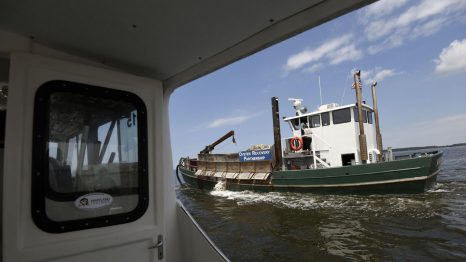 Shells carrying millions of lab-grown baby oysters tumbled down the sides of a green-hulled boat named Robert Lee, and the $35,000 investment sunk into the Choptank River where it widens to meet the Chesapeake. The oysters, planted this past week, will grow there for two or three years before watermen scoop them back up and restaurants serve them fried or on ice. Nearby, other oyster reefs are restocked in the same manner but are off-limits to harvesting. These sanctuaries across bay tributaries help the shellfish recover from decades of disease outbreaks, and overfishing before that, and have been expanded in recent years to cover nearly a quarter of the bay’s 36,000 acres of oyster bars. Watermen could soon reclaim some of that territory. Read the rest here 12:01
Shells carrying millions of lab-grown baby oysters tumbled down the sides of a green-hulled boat named Robert Lee, and the $35,000 investment sunk into the Choptank River where it widens to meet the Chesapeake. The oysters, planted this past week, will grow there for two or three years before watermen scoop them back up and restaurants serve them fried or on ice. Nearby, other oyster reefs are restocked in the same manner but are off-limits to harvesting. These sanctuaries across bay tributaries help the shellfish recover from decades of disease outbreaks, and overfishing before that, and have been expanded in recent years to cover nearly a quarter of the bay’s 36,000 acres of oyster bars. Watermen could soon reclaim some of that territory. Read the rest here 12:01
Watermen pack legislative hearing as Oyster study debate heats up in Maryland
 Oyster season may be done for now, but the debate rages on in Maryland over the future management of the Chesapeake Bay’s iconic shellfish. Watermen and seafood industry representatives packed a legislative hearing room in Annapolis on Tuesday seeking to head off legislation that would require a study to determine sustainable harvest rates for oysters. Accusations of political chicanery, bias and deception flew during a four-hour hearing before the House Environment and Transportation Committee, leaving some lawmakers baffled. Read the rest here 18:21
Oyster season may be done for now, but the debate rages on in Maryland over the future management of the Chesapeake Bay’s iconic shellfish. Watermen and seafood industry representatives packed a legislative hearing room in Annapolis on Tuesday seeking to head off legislation that would require a study to determine sustainable harvest rates for oysters. Accusations of political chicanery, bias and deception flew during a four-hour hearing before the House Environment and Transportation Committee, leaving some lawmakers baffled. Read the rest here 18:21
Chesapeake crabbers face changing workforce, murky future
Morgan Tolley is a third generation crab processor working on the shores of the Chesapeake Bay, but he’s worried that his industry may be under threat as more and more young people shun the traditional family-oriented trade. The A.E. Phillips crab picking house Tolley manages in Fishing Creek, Maryland, relies on crabs harvested by the “watermen” of the Bay. “It’s passed down from generation to generation, that’s how you learn to become a waterman. Not everybody knows how to fish a trotline or bait a crab pot,” Tolley said. Read the rest here 13:08
Best Available Science? – Video, Watermen React to Increase in Menhaden Quota Increase
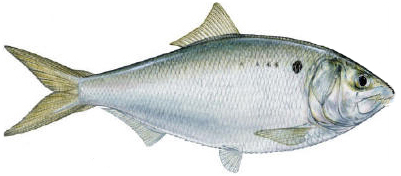 “This is a regulation that’s been overturned and it’s great for us, I mean it’s only 10 percent but you have to start somewhere. It’s a great thing for us,” said Newberry. But some watermen are still angered that they weren’t restored to their old catch limits. They’ve had a twenty percent cut in quotas since those earlier assessments. “I’ve got four men working for me. There’s five families feeding off my boat. I’ve got a 20 percent reduction for year, and now they’re like well here’s ten percent back. They didn’t need a reduction,” said Boo Powley, Read the rest here 08:23
“This is a regulation that’s been overturned and it’s great for us, I mean it’s only 10 percent but you have to start somewhere. It’s a great thing for us,” said Newberry. But some watermen are still angered that they weren’t restored to their old catch limits. They’ve had a twenty percent cut in quotas since those earlier assessments. “I’ve got four men working for me. There’s five families feeding off my boat. I’ve got a 20 percent reduction for year, and now they’re like well here’s ten percent back. They didn’t need a reduction,” said Boo Powley, Read the rest here 08:23
Watermen report Chesapeake blue crab shortage – Video
 Blue crabs are big business along the Chesapeake Bay during the summer months. They’re a Virginia tradition — steamed, deviled, or battered up and fried, blue crabs are in high demand for miles around. But this year, they’re in short supply. Read more here 08:49
Blue crabs are big business along the Chesapeake Bay during the summer months. They’re a Virginia tradition — steamed, deviled, or battered up and fried, blue crabs are in high demand for miles around. But this year, they’re in short supply. Read more here 08:49
Md. Seafood Industry Wonders How to Fix Crab Problem
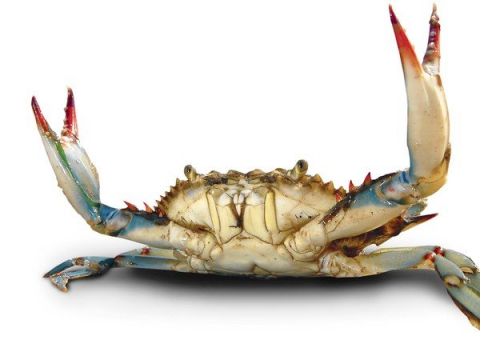 She says watermen and the state need to look at other states like the Carolinas and see how they run their fishery, and apply those lessons to the Chesapeake Bay fishery. But many, like Josh Parker at TL Morris Seafood, still believe an overabundance of rockfish are to blame. “The rockfish are just destroying them. They’re just going around eating up all the baby crabs and that’s what we end up with.” said Parker. Read more here, video 18:01
She says watermen and the state need to look at other states like the Carolinas and see how they run their fishery, and apply those lessons to the Chesapeake Bay fishery. But many, like Josh Parker at TL Morris Seafood, still believe an overabundance of rockfish are to blame. “The rockfish are just destroying them. They’re just going around eating up all the baby crabs and that’s what we end up with.” said Parker. Read more here, video 18:01
Scientists unable to completely explain the mystery of the missing blue crabs
 A year and a half ago, there seemed to be no shortage of good news about blue crabs. The annual winter dredge survey estimated 764 million blue crabs were in the Bay, the most in 19 years and a huge jump from the previous year. The governors of Maryland and Virginia issued a joint news release talking about the “extraordinary explosion in juvenile blue crab abundance.” [email protected] 13:19
A year and a half ago, there seemed to be no shortage of good news about blue crabs. The annual winter dredge survey estimated 764 million blue crabs were in the Bay, the most in 19 years and a huge jump from the previous year. The governors of Maryland and Virginia issued a joint news release talking about the “extraordinary explosion in juvenile blue crab abundance.” [email protected] 13:19

















































